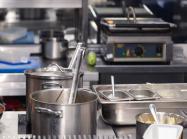Implementing integrated technology can make all the difference this coming year.
The past three years have been disruptive and unpredictable. Climate change has been destroying traditional farming. Pandemic-related backlogs—combined with factors like the Russian-Ukrainian war—have led to ongoing supply chain interruptions. Product shortages have forced restaurants to pivot, changing their menu or using substitute ingredients. And when products are available, inflation at a 40-year high means they’re significantly more expensive. Labor shortages have left restaurants scrambling. And, of course, we navigated a multi-year global pandemic. After an extraordinarily difficult few years, I’m cautiously optimistic that things will improve in 2023.
Technology will be essential to innovation and improvements in the new year. Tech has morphed from “nice to have” to an absolute necessity for restaurants, as we’ll use tech to elevate the way we train, audit, manage our suppliers, and more moving forward. Thankfully, today’s tech solutions are more affordable, accessible, intuitive, and user-friendly, allowing brands of all sizes to leverage these tools.
Here are my seven predictions on how tech will drive positive changes in the coming year:
Restaurants will use tech to manage suppliers across the supply chain. Your restaurant may be prioritizing safety and quality efforts, but if your suppliers are providing contaminated produce—or not holding refrigerated foods at proper temps—your restaurant (and your guests) are at risk. Even if you maintain the highest safety and quality standards, weak links in your supply chain can jeopardize all your hard work. Increasingly, operators will use digital tools to boost transparency across the supply chain. For instance, you can use digital tools to organize, manage and track supplier certifications in a central location, which allows you to see which suppliers prioritize safety and quality (and avoid the ones that don’t).
Boosting accuracy will increase other key metrics. Making a mistake—like serving turkey chili instead of vegetarian chili to a vegetarian guest—is a big deal. First, you’ll have to remake the meal correctly and will likely comp the meal as an apology, which means you’re making the meal twice but not getting paid for either. Beyond these tangible costs, you’ll have a disappointed (or angry) customer, who could post scathing reviews across social media and spread negative word-of-mouth all over town. Bad reviews can lead to decreased traffic, lower sales, and declining customer loyalty. If your employees make multiple mistakes per shift, the tangible and intangible costs will add up over time. Use tech tools to boost accuracy as well as visits, sales, profits, reviews, customer satisfaction and loyalty.
Tech will help drive sustainable food production. Climate change is putting traditional farming methods at risk, with extreme weather events ruining crops. Additionally, agriculture accounts for up to 30 percent of greenhouse gas emissions, due to transportation, the processing of crops and production of livestock, as well as water pollution from pesticides and fertilizers. The food industry needs to reduce agriculture’s environmental impact while increasing output to feed our growing population. Tech developments will help drive sustainability efforts in 2023 and beyond. For instance, AI can analyze data to help farmers determine when and where to plant crops for maximum yield. And blockchain helps track agricultural products from farm to table, boosting transparency and food safety across the supply chain. Technology will be instrumental to changing the way we grow and produce food, making sustainability more accessible and mainstream. Tech will also help ensure that today’s problems don’t reduce our future food supply.
Brands will prioritize DEI. Diversity drives innovation, and diverse teams produce more revenue. To boost diversity, equity, inclusion, and accountability, create an open-minded, compassionate workplace culture. This includes hiring a diverse workforce to ensure your staff represents your increasingly diverse customer base. Diverse ideas, approaches, and solutions will improve problem-solving, creativity, and innovation throughout your enterprise. Diversity, equity and inclusion are essential to securing a knowledgeable, stable, and productive workforce. This effort will help increase employee satisfaction, loyalty, and retention, as well.
Restaurants will improve training. In the future, training needs to be more than just telling employees to do things a certain way and expecting them to do it. Brands will need to explain why the rules are in place to maximize compliance. Additionally, there will be a major shift from punitive to collaborative cultures. Make sure your employees don’t fear “getting in trouble” for asking questions or pointing out infractions. Instead, build a collaborative culture, empowering employees to ask questions, proactively fix problems, and take responsibility for upholding the highest safety and quality standards. Use tech tools to amplify training efforts, reinforce knowledge, and maximize collaboration.
Hybrid options are here to stay. The pandemic accelerated the use of to-go and delivery options, and consumers still expect a hybrid of in-person, pickup and delivery from their favorite restaurants. Brands must implement best-in-class safety, quality, and accuracy protocols for each of these methods. Ensure that all your employees understand (and follow) your safety and quality protocols whether your guests are dining on-prem, picking up a takeout order, or getting food delivered. Consumers want safe, high-quality food, accurate orders, and exceptional service, regardless of whether they’re eating restaurant meals onsite or at home. Utilize tech solutions to give them exactly what they want.
Brands will take a “combo approach” to auditing. Perhaps the best thing to come out of the COVID pandemic is our approach to auditing. Traditional third-party audits largely stopped during the pandemic because of travel restrictions and other COVID precautions. Restaurants had to pivot to remote audits, where employees collaborated virtually with auditors. Brands saw many benefits to this new, virtual approach, including significant cost savings, more frequent audits, and the collaboration that made employees feel more invested in—and responsible for—safety and quality efforts. Self-assessments were also borne out of necessity, with employees conducting more frequent inspections to keep their facilities safer. For the foreseeable future, restaurants will rely on this combination approach (in-person, remote, and self-assessment) for more frequent audits and continuous improvement.
The restaurant industry has faced endless challenges, disruptions, and uncertainty over the past three years. Fortunately, the trends for next year seem more optimistic—and we’ll rely on tech tools to drive many positive changes. As you strive to maximize your brand’s successes in the new year, implementing integrated technology is the most important thing your restaurant can do.
As president of RizePoint, the longest-lasting quality management vendor in the marketplace, Kari Hensien has been instrumental in launching the company’s Ignite Supplier Certification Management solution and adding new features to make the platform even more valuable. Ignite allows companies to gather, organize, and manage supplier documentation and information in a centralized location, track status and deadlines, ensure compliance, and reduce time-consuming administrative tasks. Ignite leverages the latest tech stacks in cloud computing to deliver better speed of service, security, and performance, with shortened development cycles. For more information or to discuss RizePoint’s solutions, please contact Kari at kari.hensien@rizepoint.com.




%20(1)_099fe.png)











